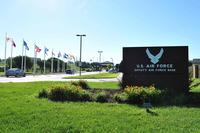The U.S. Air Force's F-35 fighter jet launched its first in-flight missile in a key software test, the service announced.
The Lockheed Martin Corp.-made F-35A on June 5 fired a Raytheon Co.-made AIM-120 advanced medium-range air-to-air missile above Naval Air Station Point Mugu, a test range in the Pacific Ocean, according to a release from the service.
The exercise was the first to perform a launch-to-eject communications sequence and will lead to targeted launches later this year as part of the software release known as Block 2B, the service said.
The event "marks a turning point" in the aircraft's development, Charlie Wagner, the service's F-35 weapons director, said in the June 7 release. "The AIM-120 launch is one small but critical increment toward proving" the single-engine jet's ability to fly combat operations, he said.
The Joint Strike Fighter is the Pentagon’s most expensive weapons program, with an estimated cost of $391 billion to develop and build 2,457 Lightning II aircraft.
The Defense Department next year plans to spend $8.4 billion to buy 29 F-35 Lightning II aircraft, including 19 for the Air Force, six for the Marine Corps and four for the Navy. The funding includes $6.4 billion in procurement, $1.9 billion in research and development and $187 million in spare parts.
Pentagon officials and lawmakers remain concerned about the aircraft's slow pace of software development.
The Marine Corps version of the jet, called the F-35B, which can take off like a helicopter and fly like a plane, is set to begin operational flights by December 2015; the Air Force’s by December 2016 and the Navy’s by February 2019, according to information released last week by the Defense Department.
The schedule has been delayed by about three years due in part to problems developing the fifth-generation fighter's software.
The Marine Corps initially expected its version of the F-35 to be ready for operations in December 2012, according to program documents. The Navy and Air Force originally put the start date at April 2016.
The Air Force plans to start flying its version of the aircraft in 2016 rather than the following year as previously planned by using software similar to the Marine Corps’ jump-jet variant. That installment, known as Block 2B, isn’t as lethal as the full software package.
By that time, the Air Force will have a squadron with at least a dozen aircraft and airmen trained and equipped to conduct basic close-air support, interdiction and limited suppression, and destruction of enemy air defenses in a contested environment, according to the release.
The full software package, known as Block 3F, is designed to support a suite of internal and external weapons, including the GPS-guided joint direct attack munition, laser-guided Paveway II bomb, advanced medium-range air-to-air missile and infrared Sidewinder missile.
The F-35A is designed to carry a payload of as much as 18,000 pounds in 10 weapon stations, including four internal stations in two weapons bays and three external weapons stations per wing.
"We're rolling into a lot of additional weapons work in the coming months to put that expanded capability on the aircraft," Lt. Col. George Schwartz, director of the F-35 integrated test force who piloted the flight, said in the release.










